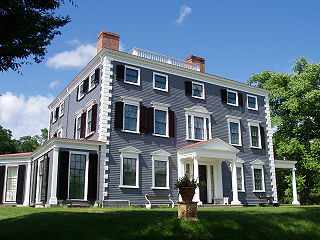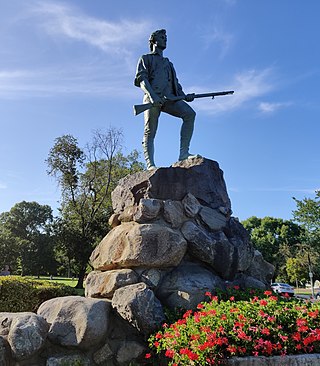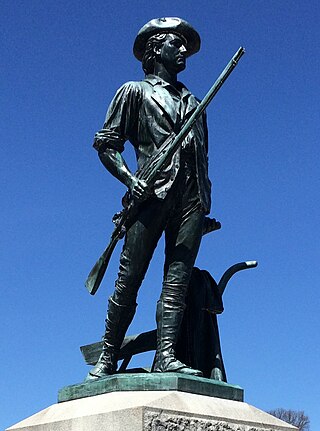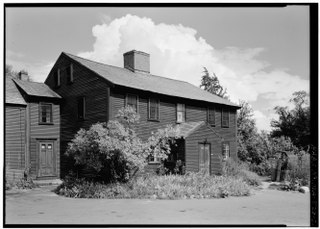
Bedford is a town in Massachusetts. The population of Bedford was 14,383 at the 2020 United States census.

Lincoln is a town in Middlesex County, Massachusetts. The population was 7,014 according to the 2020 United States Census, including residents of Hanscom Air Force Base that live within town limits. The town, located in the MetroWest region of Boston's suburbs, has a rich colonial history and large amounts of public conservation land.

Littleton is a town in Middlesex County, Massachusetts, United States. The population was 10,141 at the 2020 census.

Lexington is a suburban town in Middlesex County, Massachusetts, United States, located 10 miles (16 km) from Downtown Boston. The population was 34,454 as of the 2020 census. The area was originally inhabited by Native Americans, and was first settled by Europeans in 1641 as a farming community. Lexington is well known as the site of the first shots of the American Revolutionary War, in the Battle of Lexington on April 19, 1775, where the "Shot heard 'round the world" took place. It is home to Minute Man National Historical Park.

Samuel Prescott was an American physician and a Massachusetts Patriot during the American Revolutionary War. He is best known for his role in Paul Revere's "midnight ride" to warn the townspeople of Concord, Massachusetts, of the impending British army move to capture guns and gunpowder kept there at the beginning of the American Revolution. He was the only participant in the ride to reach Concord.

Minute Man National Historical Park commemorates the opening battle in the American Revolutionary War. It also includes the Wayside, home in turn to three noted American authors. The National Historical Park is under the jurisdiction of the National Park Service and protects 970 acres (392.5 ha) in and around the Massachusetts towns of Lexington, Lincoln, and Concord.

The Battles of Lexington and Concord, were some of the leading military engagements of the American Revolutionary War. The battles were fought on April 19, 1775, in Middlesex County, Province of Massachusetts Bay, within the towns of Lexington, Concord, Lincoln, Menotomy, and Cambridge. They marked the outbreak of armed conflict between the Kingdom of Great Britain and Patriot militias from America's thirteen colonies.

Isaac Davis was a gunsmith and a militia officer who commanded a company of Minutemen from Acton, Massachusetts, during the first battle of the American Revolutionary War. In the months leading up to the Revolution, Davis set unusually high standards for his company in terms of equipment, training, and preparedness. His company was selected to lead the advance on the British Regulars during the Battle of Concord because his men were entirely outfitted with bayonets. During the American advance on the British at the Old North Bridge, Davis was among the first killed and was the first American officer to die in the Revolution.

Battle Road, formerly known as the Old Concord Road and the Bay Road, is a historic road in Massachusetts, United States. It was formerly part of the main road connecting Lexington, Lincoln and Concord, three of the main towns involved in the American Revolutionary War. It was on Battle Road that thousands of colonial militia and British regulars fought during the redcoats' retreat from Concord to Boston on the morning and afternoon of April 19, 1775.
Mary Flint Hartwell was an American woman who played a prominent role in the battles of Lexington and Concord, during the American Revolutionary War of 1775 to 1783.

Hartwell Tavern is a historic American Revolutionary War site associated with the revolution's first battle, the 1775 battles of Lexington and Concord. It is located on North County Road, just off Battle Road in Lincoln, Massachusetts, and operated as a historic house museum by the National Park Service as part of the Minute Man National Historical Park. Built in 1733, in what was then Concord, it is staffed from Memorial Day weekend to October by park rangers dressed in colonial attire who offer programs daily.

The Samuel Hartwell House is a historic American Revolutionary War site associated with the revolution's first battle, the 1775 battles of Lexington and Concord. Built in 1733, in what was then Concord, it was located on North County Road, just off Battle Road in today's Lincoln, Massachusetts, and about 700 feet east of Hartwell Tavern, which Hartwell built for his son, Ephraim, and his newlywed wife, Elizabeth, in 1733. The site is part of today's Minute Man National Historic Park.

The Captain William Smith House is a historic American Revolutionary War site in Lincoln, Massachusetts, United States. Part of today's Minute Man National Historic Park, it is associated with the revolution's first battle, the 1775 battles of Lexington and Concord. Believed to have been built in 1692, in what was then Concord, it is believed to be the oldest house in Lincoln.

The Job Brooks House is a historic American Revolutionary War site in Lincoln, Massachusetts, United States. It is part of today's Minute Man National Historic Park.

The Jacob Whittemore House is a historic American Revolutionary War site in Lexington, Massachusetts, United States. It is part of today's Minute Man National Historic Park. It is located on Airport Road, just off Battle Road. It is the only house of the "witness" houses of the April 19, 1775 battles of Lexington and Concord to fall inside the Lexington town line; the others are in Lincoln or Concord.

The Samuel Brooks House is a historic American Revolutionary War site in Concord, Massachusetts, United States. It is part of today's Minute Man National Historic Park. It is located on North Great Road, just off Battle Road.
The Bloody Angle refers to a section of the Battle Road, in Lincoln, Massachusetts, on which two battles were fought on April 19, 1775, during the battles of Lexington and Concord, in the first stage of the American Revolutionary War. The road runs east–west, but turns north for about 500 yards (460 m) and then east again, as per the direction of travel during the British regulars' retreat from nearby Concord to Boston.

The Noah Brooks Tavern is a historic American Revolutionary War site associated with the revolution's first battle, the 1775 battles of Lexington and Concord. It stands, on the site of a previous home, on North Great Road in Lincoln, Massachusetts, just south of the former Battle Road, in an area known as Brooks Village. It is one of eleven houses within the Minute Man National Historic Park that still exists today.

Hartwell Farm was a restaurant in Lincoln, Massachusetts, United States. Established in 1925 by Marion Abbie Fitch, a Boston schoolteacher, and Jane Hamilton Poor, an architect, it occupied the 1733-built Samuel Hartwell House, on Virginia Road in today's Minute Man National Historical Park, until 1968. The building was destroyed by fire in 1973, and all that remains is its central chimney stack.
William Smith was a captain of the minutemen of Lincoln, Province of Massachusetts Bay, during the battles of Lexington and Concord, which began the American Revolutionary War.

















